The Huawei MateBook 16 Review, Powered by AMD Ryzen 7 5800H: Ecosystem Plus
by Dr. Ian Cutress on October 20, 2021 8:00 AM EST- Posted in
- Laptops
- AMD
- Huawei
- Matebook
- Ryzen
- Zen 3
- MateBook 16
- Huawei Share
- Ryzen 7 5800H
Power and Storage Performance
The processors used in the MateBook 16 are the latest Zen 3 based AMD Ryzen Mobile parts that exist as part of AMD’s H-Series range. The H-series, both on the side of AMD and Intel, typically run with a 45 W thermal design power (TDP) by definition, although depending on the mobile device being used, the manufacturers can adjust that TDP either up or down, given the desired cooling, performance, and battery life.
| AMD Ryzen 5000 Mobile: H-Series | |||||
| AnandTech | Cores Threads |
Base Freq |
Boost Freq |
TDP Default |
Vega |
| Ryzen 9 5980HX | 8C / 16T | 3300 | 4800 | 45W+ | Vega 8 |
| Ryzen 9 5980HS | 8C / 16T | 3000 | 4800 | 35W | Vega 8 |
| Ryzen 9 5900HX | 8C / 16T | 3300 | 4600 | 45W+ | Vega 8 |
| Ryzen 9 5900HS | 8C / 16T | 3000 | 4600 | 35W | Vega 8 |
| Ryzen 7 5800H | 8C / 16T | 3200 | 4400 | 45W | Vega 8 |
| Ryzen 7 5800HS | 8C / 16T | 2800 | 4400 | 35W | Vega 8 |
| Ryzen 5 5600H | 6C / 12T | 3300 | 4200 | 45W | Vega 7 |
| Ryzen 5 5600HS | 6C / 12T | 3000 | 4200 | 35W | Vega 7 |
Typically the TDP setting of a mobile processor isn’t just a ‘suggestion’ as with some of the desktop hardware: the power limit imposed by the TDP comes up very quickly after a few seconds of heavy loading, or even straight away for the slimmest of designs that are not designed for high thermal hotspots. As a result, we’re in a situation where looking at the processor name on a laptop or notebook means next to nothing for performance, and instead we need to look at the power use in a variety of scenarios. One day I hope that laptop vendors will list the configured power window for the processors they have tuned, but I don’t see it coming any time soon.
In this case, Huawei is using the Ryzen 7 5800H in our MateBook 16 unit: an 8-core, 16-thread processor with Vega 8 graphics. It has a nominal thermal design power of 45 W, but Huawei has configured it to run at 35 W. When run in this mode, the turbo frequencies are usually the same as the higher power mode, but when the system clamps on the maximum power, the all-core frequency is reduced to get to that level. The added bonus of this, aside from maintaining comfortable thermals on the device, is also that the processor runs nearer its peak efficiency point.
Huawei further spices it up by offering a PERFORMANCE mode. If the laptop is plugged into the wall with its 135 W charger, performance mode can be activated which allows individual cores access to the full 35 W. In all-core use, we see that the turbo time is increased, keeping the whole processor at 35 W for longer. The goal here is extra long-term performance, which we see in our testing in benchmarks that are long and compute-heavy, although we fail to see much benefit in gaming or day-to-day tasks.
To showcase this, we start with a traditionally heavy workload in Prime 95.
In this test, the Performance mode spikes at 52 W when the test begins, but then very quickly comes down to 35 W, which it continues all the way to the end of the test. By contrast, in the default balanced mode, we get 35 W for about 3 minutes, and then the processor scales back to 30 W.
Interestingly enough, we don’t see the same issue in Handbrake:
In this case both processors perform equally for the duration of the test, staying at 35 W, except for that initial 57 W spike when in performance mode. The test in this case took an identical amount of time to complete.
Agisoft is one of my tests that is more varied in the threaded workload, with a mix of all-core and single core tasks, and we see a can see a considerable different in the performance between the two modes.
I’ve adjusted the x-axis to % of benchmark complete, because the Performance mode completes the test about 6% quicker.
Here we see that the Performance mode stays at 35 W for most of the test, until the last 15% which is more single-threaded. The Balanced mode gets knocked back almost immediately to 30 W, before reducing further to 20 W. The whole test takes around 20 minutes, and the Balanced came down to 20 W around the 14-minute mark. But overall, the performance mode was quicker, at the expense of extra power.
Storage Performance
The MateBook 16, regardless of which model you buy, will come with 16 GB of DDR4-3200 and a 512 GB NVMe SSD inside. The storage in our laptop is a Samsung PM981a, which is the same PCIe 3.0 x4 drive that Huawei has been putting inside its laptops for at least two generations, if not three. It’s still a good performer, and compared to the 1 TB version we saw in the MateBook X Pro in our previous review, it is a tiny bit faster.
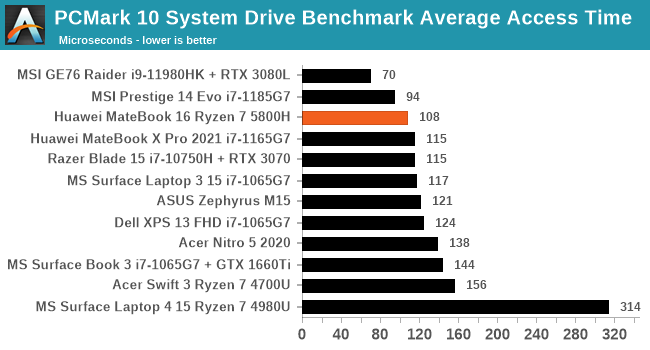
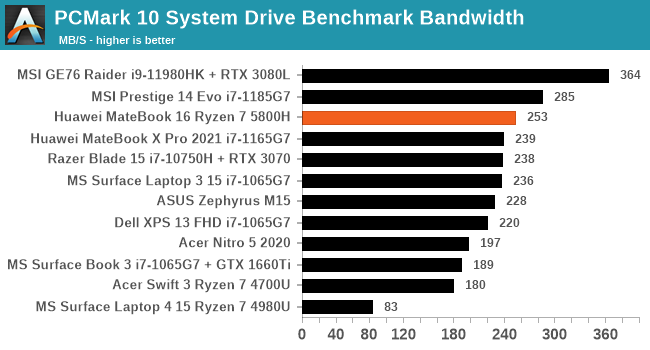
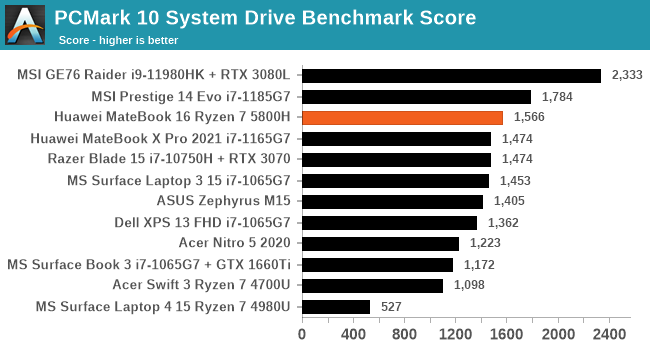
While Huawei continues to use the lowest SKU of the respective stack, such as the lowest Core i7 in the Core i7-1165G7 for the MateBook X Pro and the lowest Ryzen 7 for the Ryzen 7 5800H in the MateBook 16, there isn’t much reason for them to use anything other than the PM981a, as it remains a good drive.


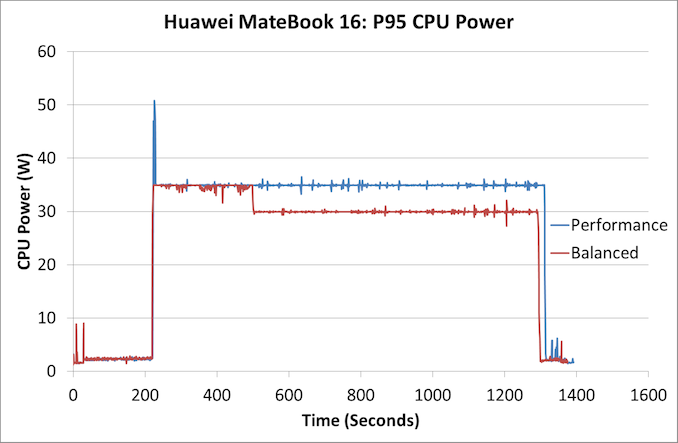
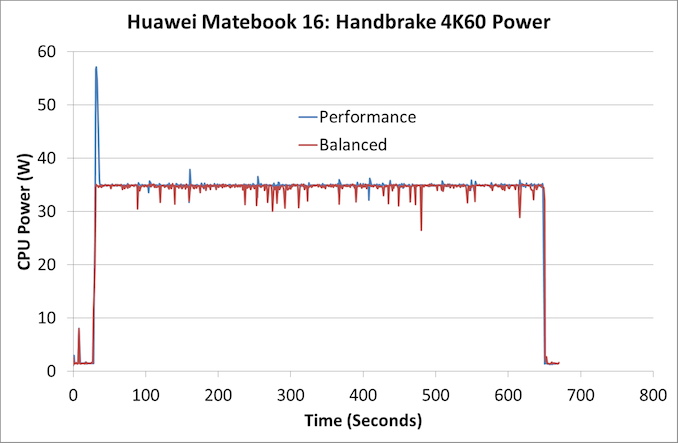
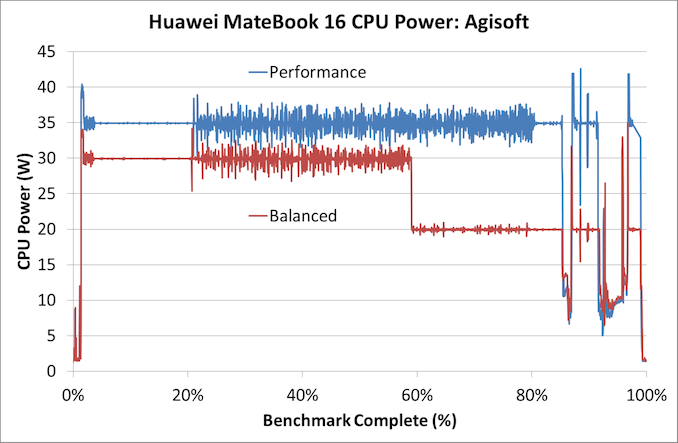








87 Comments
View All Comments
anandcx - Wednesday, October 20, 2021 - link
Gram 17 has 80wh battery, you have linked a two years old model you fool. Since 2020 all Gram 17's have 80wh battery, this is the link for 2021 model: https://www.lg.com/us/laptops/lg-17z90p-k.aas9u1-u...Prestissimo - Wednesday, October 20, 2021 - link
What? Battery is quite small for a 45W CPUbenedict - Wednesday, October 20, 2021 - link
I'm amazed companies keep pushing laptops with 512GB SDDs and pretend they are not crap. 1 TB of storage is the absolute minimum any new pc or laptop should have if you don't want to buy a second SSD in a few months.stephenbrooks - Wednesday, October 20, 2021 - link
I guess people can use them with external drives, but yes, if a laptop or PC has under 1TB of built-in storage it better be priced economically.Tomatotech - Thursday, October 21, 2021 - link
Yup. People don't realise that many SSDs slow down quite a lot as they get full up. My 1TB NVMe SSD is one of these that fold empty TLC space into a SLC buffer. What that means with my particular SSD is that it only runs at max speed up to about 66% full then after that it slows down, as shown in benchmarks and daily feel if it goes over around 650GB full.Practically, I treat it as giving me around 600GB of long-term working storage plus another 350GB of emergency / temporary storage. I knew this before buying it and I'm happy with it, though I would like my next SSD to be 2TB as I'm hovering round the 550GB long term storage mark at the moment.
TheinsanegamerN - Wednesday, October 20, 2021 - link
Not everyone compiles videos from 8k120hz video all day. 512GB is not a hindrance to most. And you can just upgrade it yourself instead of paying a premium to get it pre installed.Prestissimo - Thursday, October 21, 2021 - link
My laptop running W11 has a 128GB SATA 3 SSD and it's blazing fast for everyday tasks. All my data's on my internal storage as well, synced up to Google Drive. We don't need higher capacity PCIe 4.0 SSDs driving up base laptop prices for the general public.Stop speaking for everyone else, it's arrogant and presumptuous.
schujj07 - Thursday, October 21, 2021 - link
If all you aren't storing boat loads of videos, photos, music, or games then 512GB is plenty for OS/Application drive. My work laptop has a 256GB SSD and that isn't an issue as a lot isn't stored on the laptop.fishingbait15 - Friday, October 22, 2021 - link
The people who would buy a device like this are probably 50/50 web cloud and 50/50 local stuff. It doesn't have a dGPU so no AAA gaming and no content creation. People who are doing full stack programming or virtualization would likely opt for CPU with more cores. The days when people had massive libraries of purchased iTunes videos and TV shows are over ... that stuff is streamed now.DominionSeraph - Friday, October 22, 2021 - link
My C:\ drive is using 286GB, 200GB of which is games. Very few people use laptops for much more than internet/office tasks which doesn't even take 50GB if you nuke the hiberfil file. 512GB is overkill for most users.